Garlic and Herb Labneh Balls in Olive Oil
These delicious labneh balls stay preserved in olive oil for a month or more – always ready for an impromptu snack. Roll them in za’atar, chilli powder or sesame seeds and serve as part of a mezze spread. Or simply spread on a slice of sourdough.
Labneh, the Arabic strained yoghurt cheese, is a staple in my house – always ready for effortless dips and spreads. These garlic and herb labneh balls are even more convenient to have on hand, perfectly flavoured and ready to go.
You can store the labneh balls in olive oil in the fridge for a month or more!
They are delicious in summer salads or popped into warm and spicy soups. Serve them on a mezze platter for impromptu guests. And, of course, I love to squash and spread a flavoured labneh ball on my morning slice of sourdough before topping it with a boiled egg.
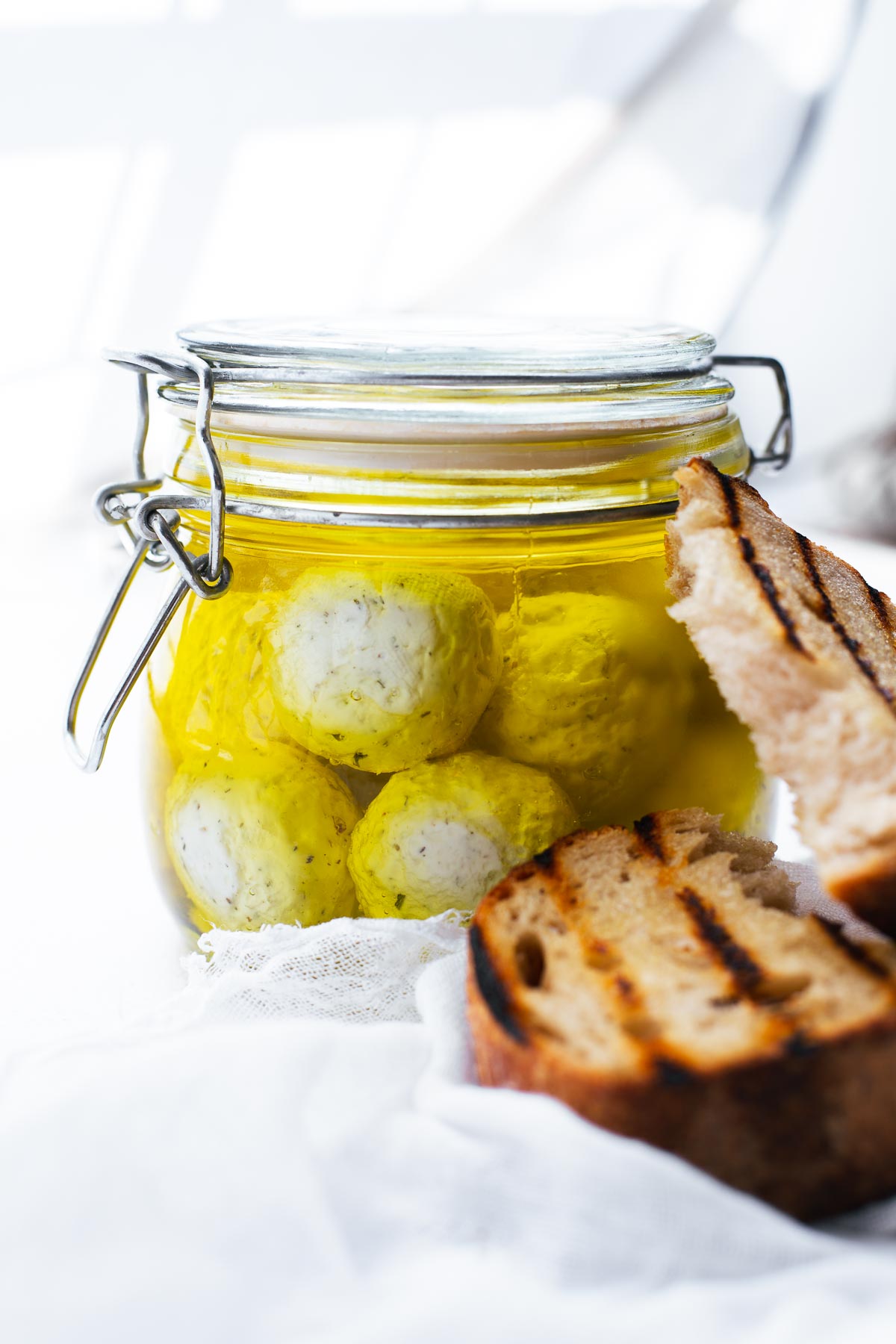
Homemade labneh
You can use store-bought labneh, but homemade labneh cheese is so easy to make I definitely recommend trying it at least once! Simply strain full-fat plain yoghurt (or Greek yoghurt) through muslin cloth until it is thick enough to roll into balls – 24 to 48 hours.
I like to keep the muslin-secured ball of salted yoghurt in the fridge suspended in a fine mesh sieve with something heavy on top to speed up the process.
If you make the labneh at home, note that different yoghurts yield different quantities. For example, my favourite double cream yoghurt (thick Greek-style yoghurt) loses 30 % in weight, whereas the full-fat goat’s yoghurt loses more than 50 %!
The thinner your yoghurt, the more liquid (whey) will drain away. I prefer a mix of goat and cow’s milk yoghurts that I strain for two days until nice and dry. But you can use any full-fat, unflavoured yoghurt.
The labneh balls recipe card includes the instructions for making labneh balls from scratch. But if you want to learn more, check out my homemade labneh recipe for all the homemade yoghurt cheese tips and tricks. Spoiler alert: It’s super easy!
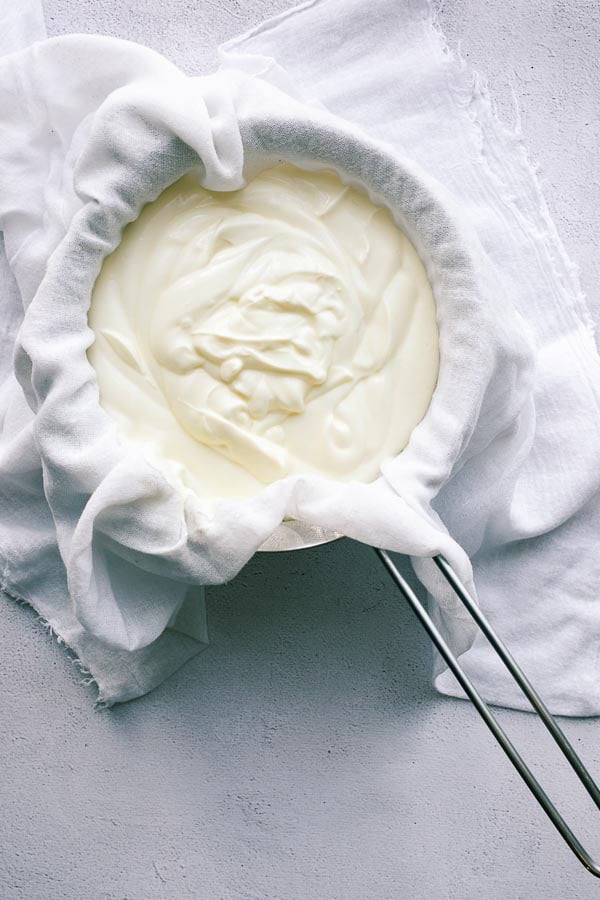
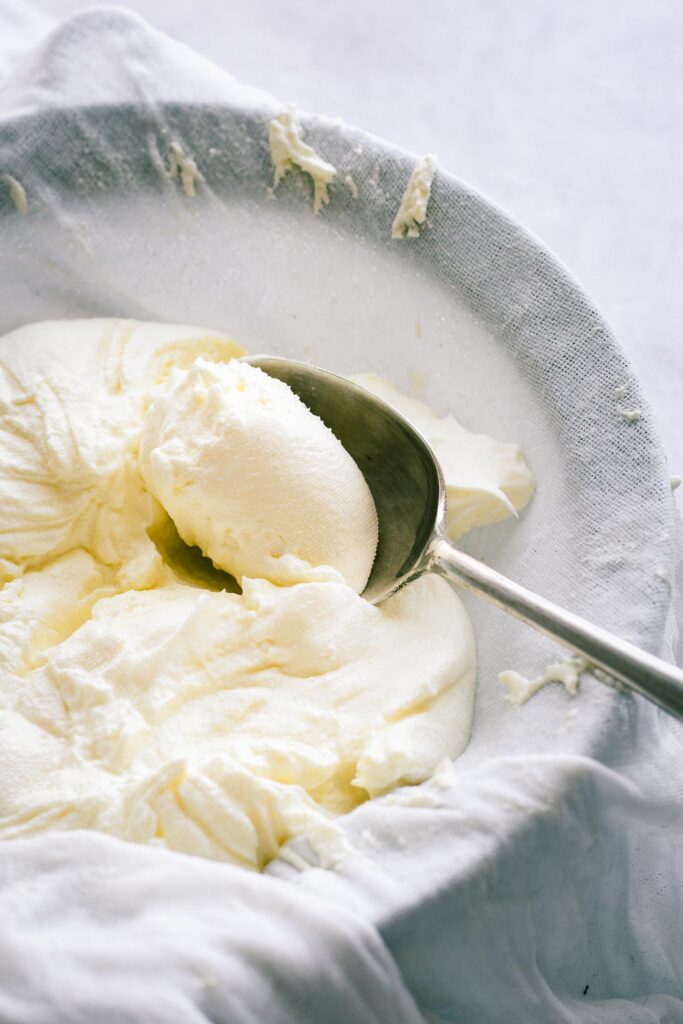
Garlic and herb labneh
You can use plain labneh for your homemade labneh balls, but I love to flavour the strained yoghurt with a dried herb and garlic mix.
Garlic and herb labne balls are like little Boursin garlic and herb cheese balls – Boursin is a French creamy soft cheese expertly flavoured with garlic and herbs and it’s worth tracking down if you haven’t tried it yet!
For garlic and herb labneh, thoroughly mix your labneh cheese with dried herbs, garlic powder and salt. Use roughly 1½ teaspoons of dried herbs and ¼ teaspoon of garlic powder per cup of labneh. Add salt to taste – I add ½ teaspoon of salt per cup of labneh yoghurt cheese.
Experiment with different dried herbs such as tarragon, oregano, dill, sage, thyme, parsley, basil, mint, chives or marjoram. I give my favourite combination in the recipe card below, but you can use what you have at home – tasting and adding more as you go.
You can also try herb blends, like Italian seasoning.
Or better yet, dry your own leftover herbs. Learn how to dry parsley in the oven and apply the method to any fresh herbs.
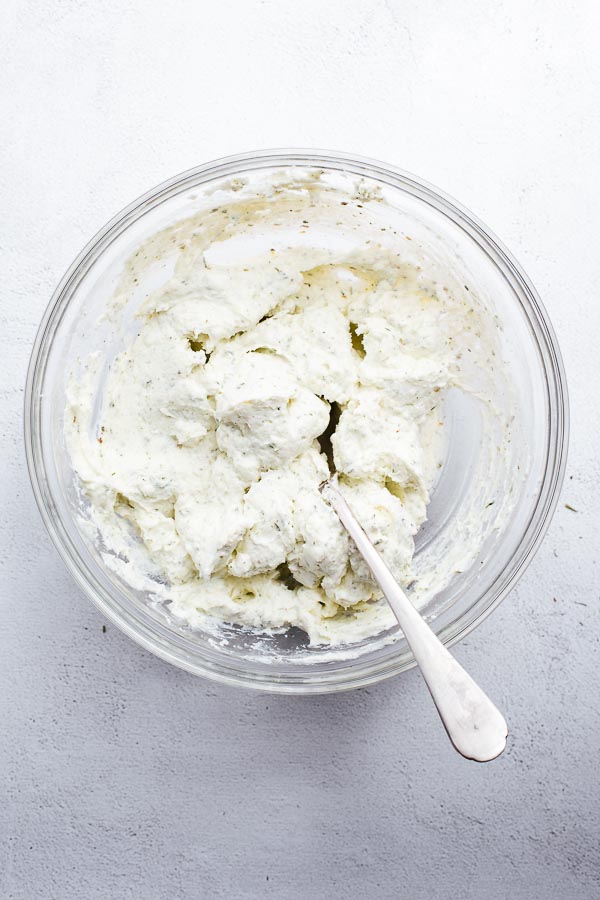
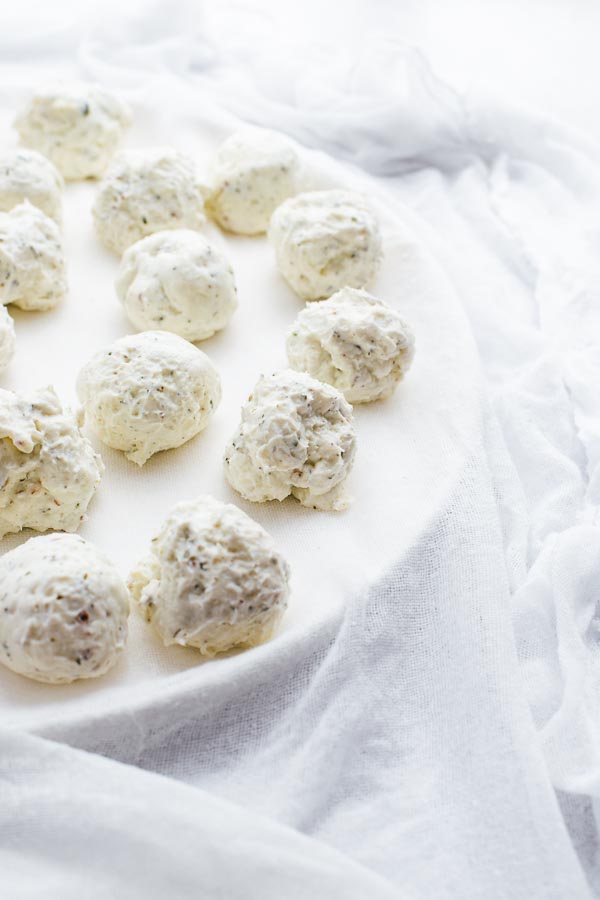
How to make labneh balls (plain or flavoured)
Step 1: Take a tablespoon of garlic and herb labneh (or plain labneh) and roll it into a ball with lightly oiled hands, roughly 20 to 30 grams each. It is OK if your balls look a bit uneven, you will get an opportunity to roll them smoothly later.
Step 2: Place the rough labneh balls on a plate lined with a clean, damp tea towel or muslin. Fold the cloth over the balls (or use a second cloth) and place them in the fridge to set and dry overnight – or longer, depending on your schedule.
Tip: If you struggle to roll your labneh into balls, your labneh is most likely not strained enough. You can strain it for longer, or portion the labneh into mounds onto a dry muslin cloth or tea towel. Allow them to set overnight before attempting to roll them again.
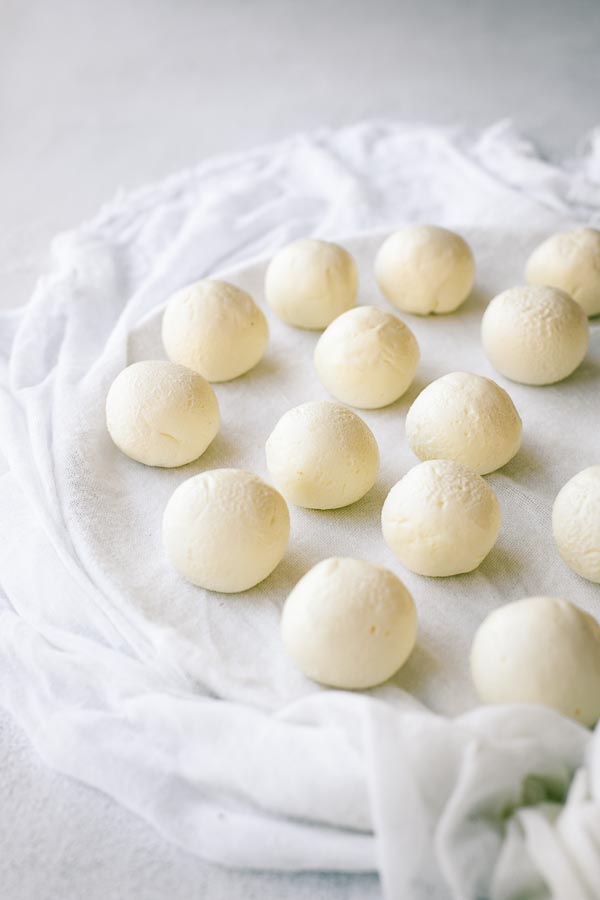
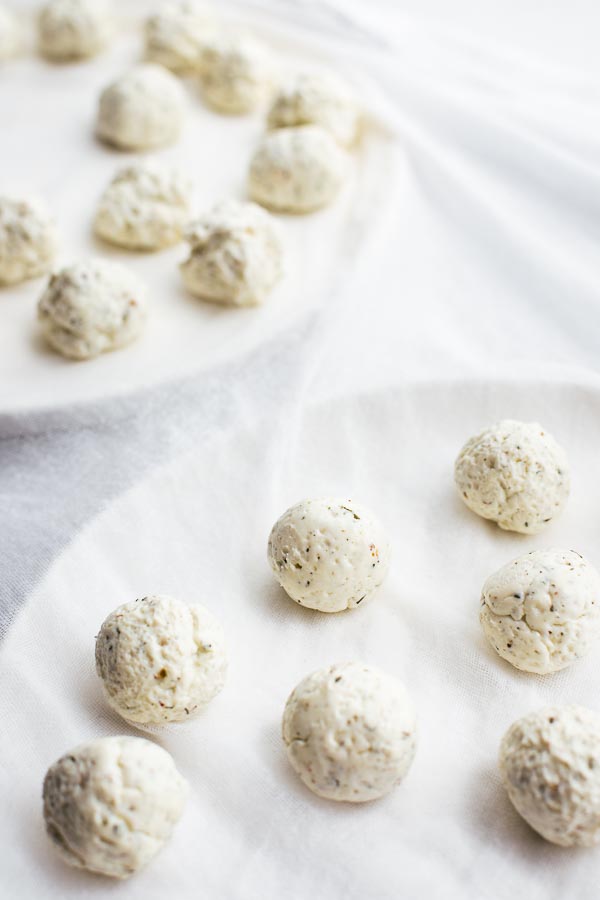
Step 3: Once set, remove the balls from the fridge. With lightly oiled hands, roll the labneh balls between your palms to smooth out the rough texture.
You can now keep the balls stacked in an airtight container in the fridge for up to 1 week. Or, if you would like to keep it for longer, preserve the labneh balls in olive oil.
How to store labneh balls in olive oil
You can store the labneh cheese balls in olive oil to extend their freshness.
1. Start with good quality olive oil (and don’t waste it)
Use good quality extra virgin olive oil because the olive oil characteristics will linger with the labneh yoghurt balls.
You need a lot of olive oil for this, so please don’t discard it once your labneh balls are finished. The garlic and herbs will gently flavour the olive oil. So, as you carefully fish out your labneh balls, you can use olive oil for salad dressings or cooking.
Just ensure that the labneh balls stay submerged in olive oil – add more oil if needed.
2. Use sealable glass jars for storage
Place half a cup of extra virgin olive oil in a sterilised, sealable glass jar. Add a few labneh balls with more olive oil – enough to completely cover the labneh balls.
Add another layer of labneh balls followed by more olive oil.
Repeat until all the labneh balls are completely submerged in olive oil. I like to store a single batch of labneh balls in two smaller glass jars instead of one large container. Use what you have available.
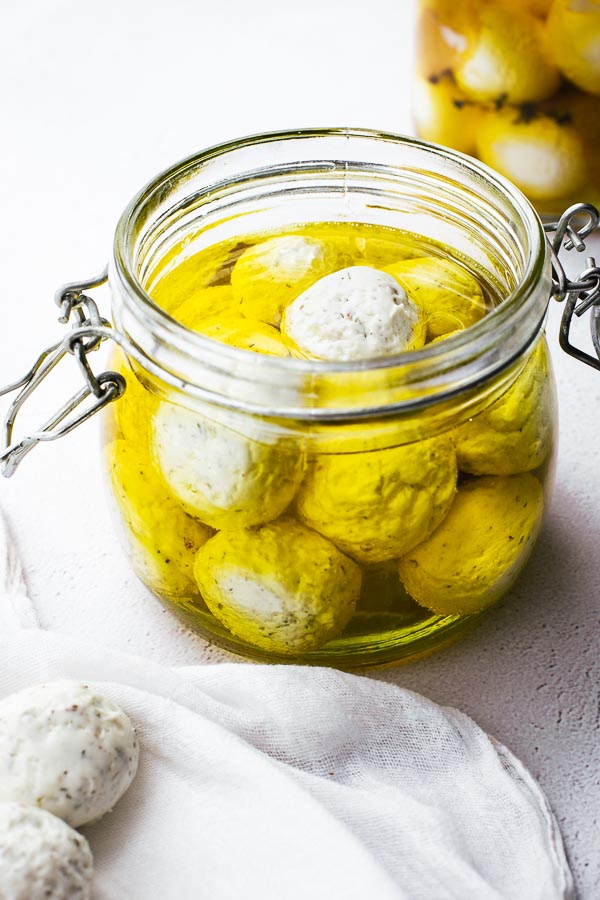
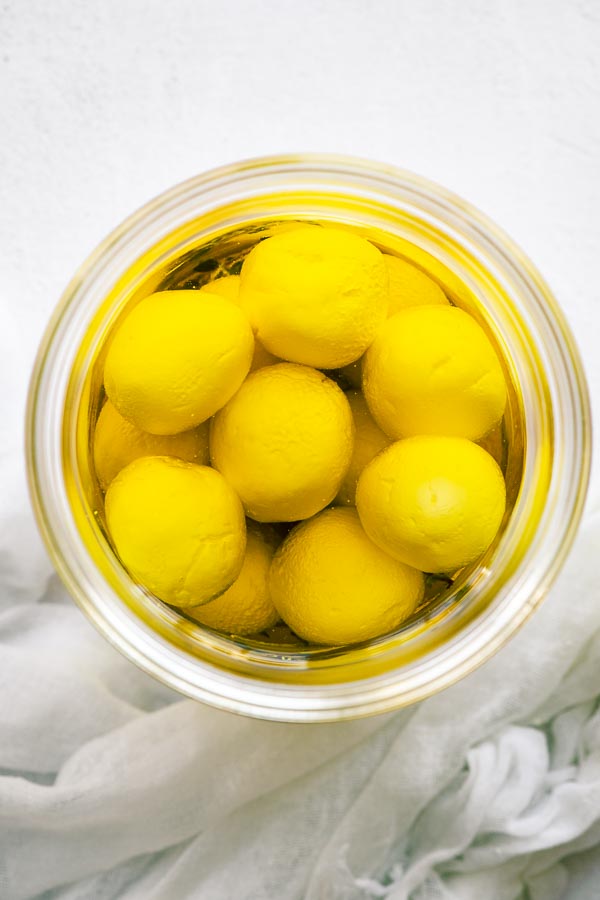
Resist the urge to shake the jar to make the labneh balls settle in place. It will leave smears all over the glass. And if you’re anything like me, those smears will drive you up the wall – even though it’s technically fine.
Instead, give the jar a gentle tap on the kitchen counter to release any air bubbles and help the cheese balls settle.
3. Refrigerate
Refrigerated garlic and herb labneh balls in oil keep for up to a month. And plain, salted labneh balls keep for up to two months.
However, the oil solidifies over time. Before serving, place the container at room temperature until the oil is liquid enough to easily remove a labneh ball – maybe an hour, depending on your patience. Return the jar to the fridge until needed again.
Spice-coated labneh balls
Roll plain unflavored labneh balls in assorted spices before serving. This jewel box of spiced labneh balls is a genius idea by Sami Tamimi from his book Falastin.
Play around with your spices for a clash of colours and flavours. Use chilli flakes (like Urfa chilli flakes, red pepper flakes, or Aleppo pepper flakes), za’atar, nigella seeds, fresh or dried lemon zest, black sesame seeds, sumac, dried rose petals, or chopped pistachios. Or try a homemade spice blend like dukkah, Italian seasoning, or harissa powder.
Simply roll the labneh cheese balls in your different coloured spices for a striking plate of multi-coloured labneh balls.
You can do this a day ahead of serving. Refrigerate the spiced labneh balls in an airtight container – don’t return them to the oil.
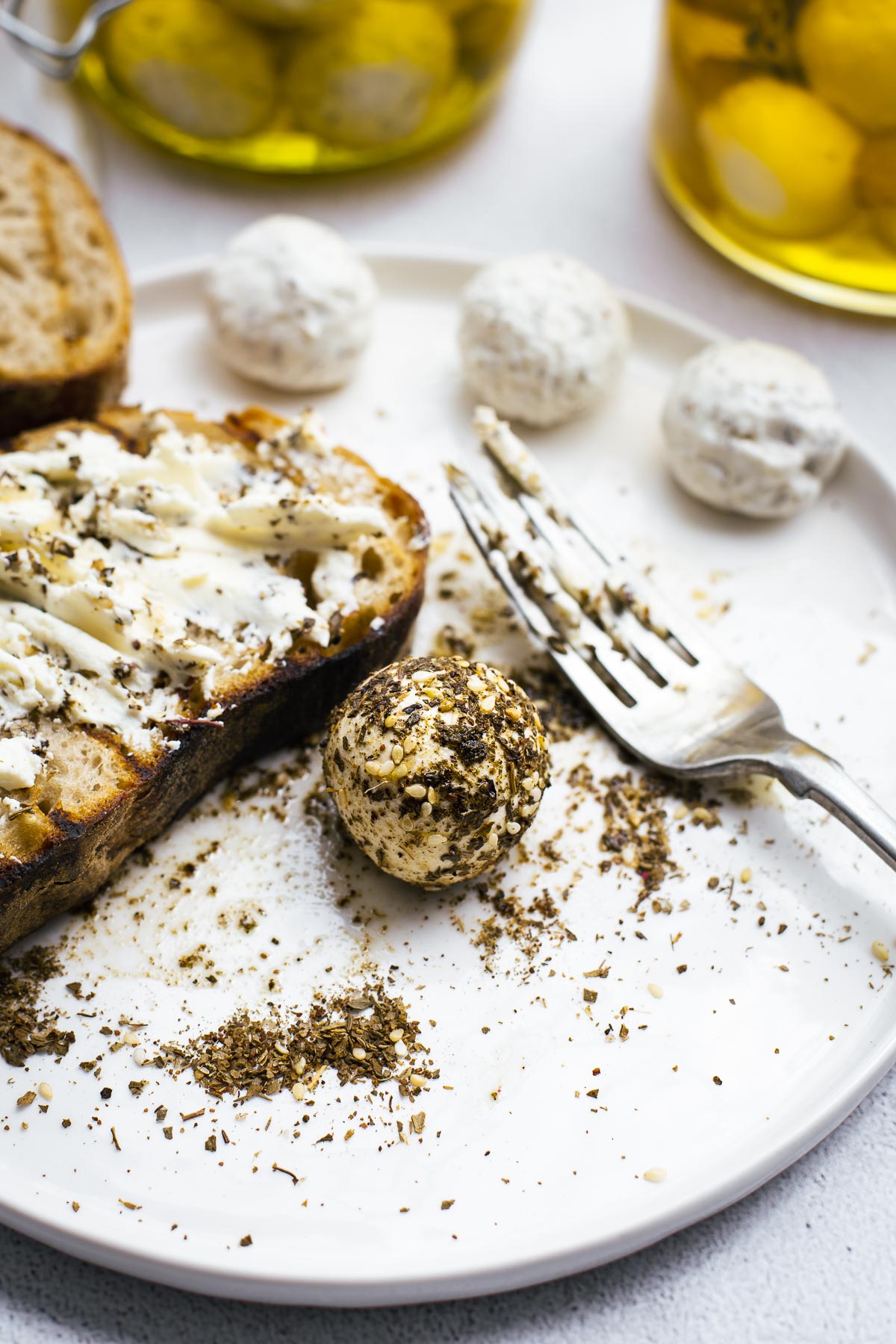
Frequently asked questions
Labneh is soft Middle Eastern cheese made from plain yoghurt. Straining the yoghurt removes liquid whey resulting in a thick and spreadable soft cheese.
In traditional Arab cuisine, labneh dips and spreads are served with bread to scoop it up. But modern recipes combine labneh with anything from roasted vegetables to salads.
Greek yoghurt is strained yoghurt, it has a creamy texture. Labneh is also strained yoghurt, but it is strained until the texture is thick and spreadable like a soft cheese. You can make labneh from Greek yoghurt (but not the other way around).
How to eat labneh balls
Serve labneh balls on a mezze platter with warm pita bread like this falafel plate. They are delicious with authentic crispy falafel or baked falafel.
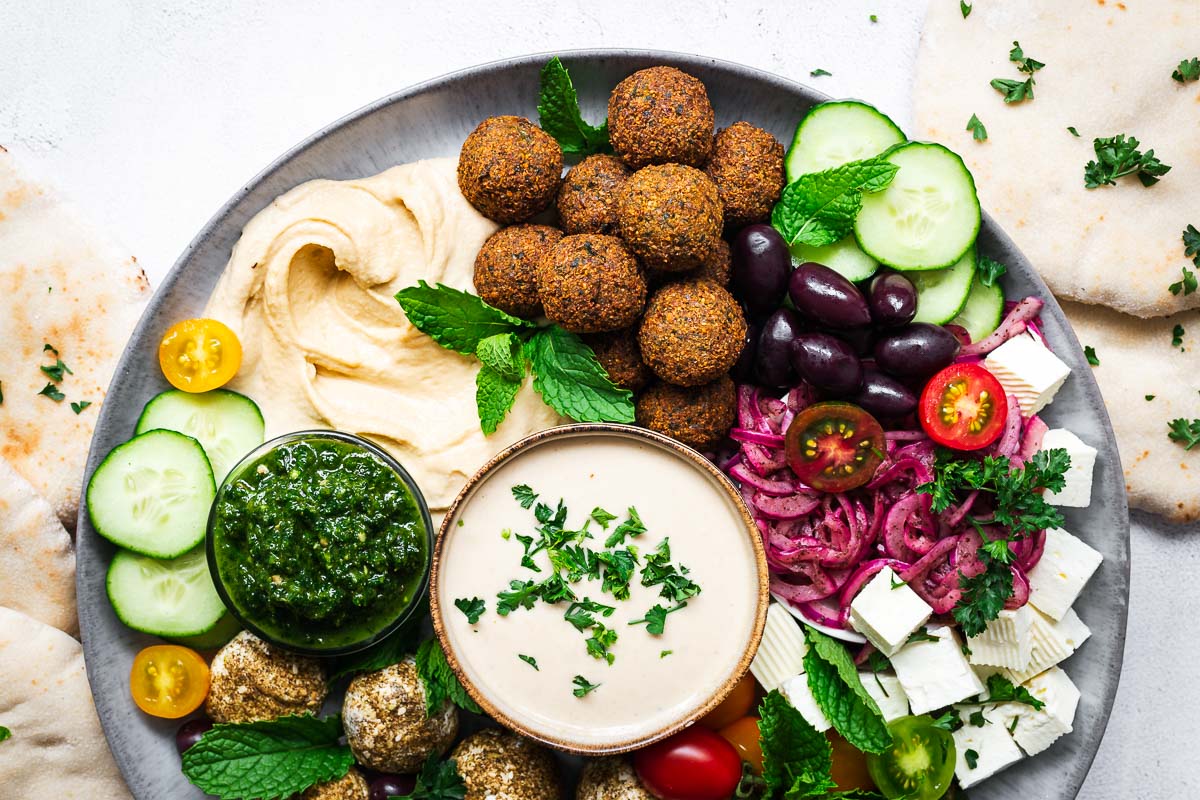
Use labneh balls as a substitute for goat’s cheese in salads. Try them in this artichoke and goat’s cheese salad.
Pop a soothing yoghurt cheese ball in a spicy soup instead of yoghurt or cream – like this spicy harissa red lentil soup.
Or simply smoosh a labneh ball on a slice of crusty bread. Add a boiled egg and drizzle with some olive oil from the jar for a delicious Middle Eastern breakfast. Finish with flaky salt and a squeeze of lemon juice.
No matter how you choose to flavour your labneh balls – garlic and herb, plain, or coated in za’atar – having labneh balls ready for your morning toast, impromptu cheese platters and salads are an absolute treat. And a healthy one at that!
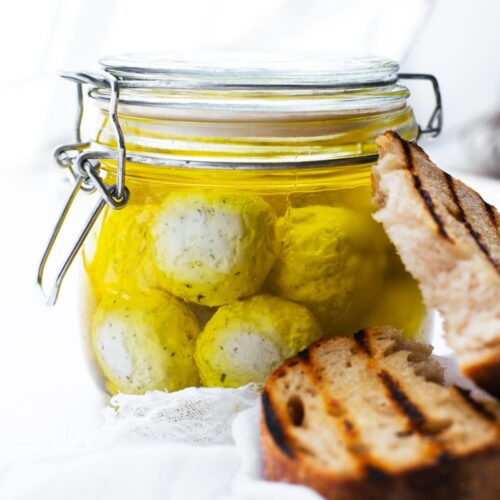
Ingredients
- 4 cups full-fat yoghurt (Greek-style yoghurt is perfect)
- 1 teaspoon salt, plus more to taste
For garlic and herb labneh (optional)
- ½ teaspoon garlic powder
- 1 teaspoon dried tarragon
- ½ teaspoon dried oregano
- ½ teaspoon dried dill
- ½ teaspoon dried sage
- ½ teaspoon dried thyme
To preserve labneh balls in olive oil (optional)
- 2 cups extra virgin olive oil or more to submerge labneh balls
Instructions
Make labneh
- Mix 1 teaspoon salt with the yoghurt. Balance a fine mesh strainer over a large bowl and line the strainer with muslin (cheesecloth) – leaving a large enough overhang of cloth to secure the yoghurt inside. Spoon the yoghurt and salt mixture into the muslin-lined strainer. Secure the yoghurt inside the muslin by folding it or tying it with string. Yoghurt should not leak out. Instead, liquid whey should strain through the fabric. Place a heavy object on top of the secured yoghurt to speed up straining.
- Place everything in the fridge and leave the yoghurt to strain for 24 to 48 hours until the labneh is thick – almost like cream cheese. Be sure that there is enough room for the liquid to collect without touching the yoghurt – discard liquid as needed.
Flavour the labneh (optional)
- Once the labneh is thick enough to roll into rough balls, place the labneh in a bowl and add the garlic powder, dried herbs, and salt to taste – I add ½ teaspoon salt. Mix very well with a fork until the herbs are distributed evenly.
Roll the labneh balls
- With lightly oiled hands, roll the labneh into rough even-sized balls. I use a heaped tablespoon – between 20 and 30 grams – per ball.
- Place the rough labneh balls on a plate lined with a clean, damp tea towel or muslin. Refrigerate it to set overnight (or for at least 2 hours).
- Remove the balls from the fridge and, again using lightly oiled hands, smooth over the labneh balls by applying gentle pressure and rolling the labneh balls between your palms.
Storing labneh balls
- Refrigerate the balls in an airtight container for up to 1 week.
- Or preserve them in olive oil. Place half a cup of extra virgin olive oil in a sterilised, sealable jar. Drop in the first few labneh balls and cover with olive oil. Repeat until the container is filled and all the labneh balls are completely submerged in olive oil. Refrigerate garlic and herb labneh balls in olive oil for up to 1 month, or plain labneh balls in olive oil for up to 2 months.
Notes
- For more in-depth notes on making labneh, see this post on how to make labneh.
- Different yoghurts will have different labneh yields. The yoghurt I use yields about 2 cups of labneh. I use roughly 1½ teaspoons of dried herbs per cup of labneh.
- You can use fresh herbs if you plan on eating the labneh balls within a few days. Don’t store fresh herbed labneh balls in olive oil.
- When you refrigerate the labneh balls in olive oil, the olive oil will eventually solidify. Simply leave it at room temperature for an hour for the oil to soften before fishing out the labneh balls. Return the jar to the fridge until needed again.
Middle Eastern recipes to serve with labneh balls
- Falafel plate: A classic mezze platter that pairs beautifully with the fresh cheese.
- Harissa roasted cauliflower: A buttery, spicy and indulgent vegetarian main to serve with Persian yoghurt.
- Barley pilaf with rose harissa: An easy Middle Eastern pilaf to pair with mast-o khiar.
- Persian eggplant stew: Slow-roasted eggplant stew with lentils and black lime.
- Arabic salad: A classic Middle Eastern-style chopped salad to serve alongside the yoghurt side dish.
- Kuku sabzi: An easy Persian herb frittata recipe packed with greens and just enough eggs to hold it all together.

Hi Adri,
thanks a ton for your reply! i decided to go for dried herbs so the labneh keeps for longer. also added some lemon zest which really alleviated it even more <3
But despite the yoghurt being strained for around 40hrs it was still creamy and i couldn't make balls out of it. But it tastes good as a spread just the same!
I’m happy to hear that the flavour turned out great!
Not sure which yoghurt you used, but it helps to start with thick full-fat yoghurt. The thinner the yoghurt, the longer it needs to strain before it’s a rollable texture.
But, if you still have some herbed labneh spread (that’s too thin to roll into balls), try the following: Spoon them into rough heaps on a plate lined with a tea towel or muslin cloth. Let them dry in the fridge for 2 hours. Then try to roll the heaps into balls, they should be easier to handle and roll into balls.
Hi, this recipe looks fab, love the herb mixture! i have 500gms of yoghurt straining in the fridge right now and would love to use fresh herbs from my balcony instead of the dried ones. i have dill, basil and oregano. How many total tspns of herbs do you think i should go for? Thanks!!
Hi Raiza,
That sounds delightful!
Dried herbs are more intense than fresh herbs. The general consensus is to use a 3:1 substitute ratio to match the flavour intensity.
So, instead of the 3 teaspoons of dried herbs, I would go for 9 teaspoons (3 tablespoons) of finely chopped fresh herbs. It should also give your labneh a beautiful green colour.
Just remember that when you use fresh herbs, it is best to refrigerate the labneh balls and eat them within a few days.
Enjoy!